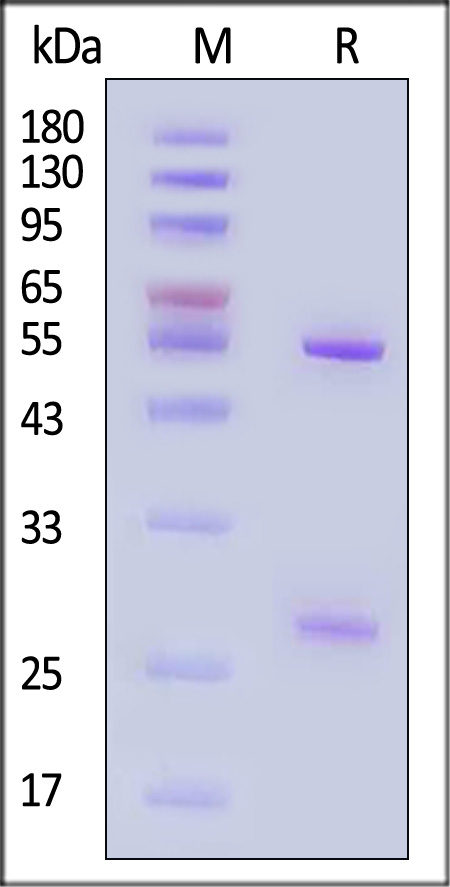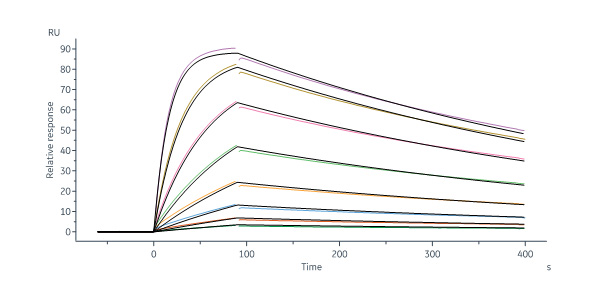抗体来源(Source)
Monoclonal Anti-Monkeypox virus (strain Zaire-96-I-16) A17L Antibody, Human IgG1 (1B4) is a chimeric monoclonal antibody recombinantly expressed from HEK293, which combines the variable region of a mouse monoclonal antibody with Human constant domain.
克隆号(Clone)
1B4
亚型(Isotype)
Human IgG1 | Human Kappa
偶联(Conjugate)
Unconjugated
抗体类型(Antibody Type)
Recombinant Monoclonal
种属反应性(Reactivity)
Virus
免疫原(Immunogen)
Recombinant Monkeypox virus (strain Zaire-96-I-16) A17L Protein is expressed from human 293 cells.
特异性(Specificity)
Specifically recognizes Monkeypox virus (strain Zaire-96-I-16) A17L.
应用(Application)
| Application | Recommended Usage |
| ELISA | 0.06-15 ng/mL |
纯度(Purity)
>90% as determined by SDS-PAGE.
纯化(Purification)
Protein A purified / Protein G purified
制剂(Formulation)
Lyophilized from 0.22 μm filtered solution in PBS, pH7.4 with trehalose as protectant.
Contact us for customized product form or formulation.
重构方法(Reconstitution)
Please see Certificate of Analysis for specific instructions.
For best performance, we strongly recommend you to follow the reconstitution protocol provided in the CoA.
存储(Storage)
For long term storage, the product should be stored at lyophilized state at -20°C or lower.
Please avoid repeated freeze-thaw cycles.
This product is stable after storage at:
- -20°C to -70°C for 12 months in lyophilized state;
- -70°C for 3 months under sterile conditions after reconstitution.
质量管理控制体系(QMS)
电泳(SDS-PAGE)

Monoclonal Anti-Monkeypox virus (strain Zaire-96-I-16) A17L Antibody, Human IgG1 (1B4) on SDS-PAGE under reducing (R) condition. The gel was stained with Coomassie Blue. The purity of the protein is greater than 90% (With Star Ribbon Pre-stained Protein Marker).
活性(Bioactivity)-ELISA

Immobilized Monkeypox virus (strain Zaire-96-I-16) A17L Protein, His Tag (Cat. No. A1L-M52H3) at 1 μg/mL (100 μL/well) can bind Monoclonal Anti-Monkeypox virus (strain Zaire-96-I-16) A17L Antibody, Human IgG1 (1B4) (Cat. No. A1L-M698) with a linear range of 0.06-2 ng/mL (QC tested).
Protocol
活性(Bioactivity)-SPR

Monoclonal Anti-Monkeypox virus (strain Zaire-96-I-16) A17L Antibody, Human IgG1 (1B4) (Cat. No. A1L-M698) captured on Protein A Chip can bind Monkeypox virus (strain Zaire-96-I-16) A17L Protein, His Tag (Cat. No. A1L-M52H3) with an affinity constant of 7.98 nM as determined in a SPR assay (Biacore 8K) (Routinely tested).
Protocol
背景(Background)
Monkeypox is a rare zoonosis caused by monkeypox virus, which has become the most serious orthpoxvirus and consists of complex double stranded DNA. The pathogenesis of monkeypox is that the virus invades the body from respiratory mucosa, multiplies in lymphocytes, and incurs into blood producing transient venereal toxemia. after the virus multiplies in cells, the cells can invade the blood and propagate to the skin of the whole body, causing lesions. A17L is essential for an early step in virion morphogenesis.























































 膜杰作
膜杰作 Star Staining
Star Staining















